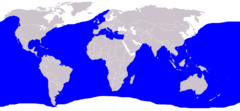Blue shark
2007 Schools Wikipedia Selection. Related subjects: Insects, Reptiles and Fish
| iBlue shark | ||||||||||||||||
|---|---|---|---|---|---|---|---|---|---|---|---|---|---|---|---|---|
 |
||||||||||||||||
|
|
||||||||||||||||
| Scientific classification | ||||||||||||||||
|
||||||||||||||||
|
|
||||||||||||||||
| Prionace glauca (Linnaeus, 1758) |
||||||||||||||||
 Range of blue shark
|
The blue shark, Prionace glauca is a carcharhinid shark which is found in the deep waters of the world's temperate and tropical oceans. They prefer cooler waters and are not found, for example, in the Gulf of Mexico, the Adriatic or Red Sea. Blue sharks are known to migrate long distances, from New England to South America for example. Although generally lethargic, they are capable of moving very quickly if the need arises. Blue sharks are viviparous and are noted for their large litters of 25 to over 100 pups. They feed primarily on small fish and squid, although they are perfectly capable of taking larger prey should the opportunity present itself. They are often found in schools segregated by sex and size.
Distribution and habitat
The blue shark is an oceanic and epipelagic shark found worldwide in deep temperate and tropical waters from the surface to about 350 meters. In temperate seas it may come closer to shore where it can be observed by divers, while in tropical waters it occurs at greater depths. It is found from as far north as Norway to as far south as Chile. In the Pacific its greatest concentrations occur between 20° and 50° North but with strong seasonal fluctuations. In the tropics it is uniformly distributed between 20° N and 20° S. It prefers waters with a temperature range of 7–16° C but will tolerate temperatures of 21° C or above. It is highly migratory with records from the Atlantic showing a regular clockwise migration within the prevailing currents.
Anatomy and appearance
Blue sharks are light-bodied with long pectoral fins. The top of the body is deep blue and lighter on the sides. The underside of the shark is white. The animal grows to 3.8 meters or more, but the usual size is 1.8 to 2.4 m. The shark's typical weight is 60 to 80 kg. The largest recorded specimen weighed 205 kg. Blue sharks in the Pacific are generally smaller and do not exceed 2 m (6 ft). They are not typically confused with any other species.
Diet
Squid are an important prey item for blue sharks, but their diet also comprises other invertebrates such as cuttlefish and pelagic octopuses, as well as lobster, shrimp, crab, a large number of bony fishes, small sharks, mammalian carrion and occasional sea birds Whale and porpoise blubber and meat have been retrieved from the stomachs of captured specimens and they are known take cod from trawl nets.
Reproduction
They are vivaporous, with a yolk-sac placenta, delivering 4 to 135 pups per litter. The gestation period is between 9 and 12 months. Females mature at 5 to 6 years of age and males at 4 to 5. Courtship is believed to involve biting by the male, as mature specimens can be accurately sexed according to the presence or absence of bite scarring. Female blue sharks have adapted to the rigours of the mating ritual by developing skin 3 times as thick as that of the male.
Importance to humans
Blue sharks are the most heavily fished sharks in the world mainly as result of bycatch. It is estimated that 10 to 20 million individuals are killed each year as a result of fishing.. The flesh is edible, but not widely sought after; it is utilized fresh, dried, smoked and salted and for fishmeal. The skin is used for leather, the fins for shark-fin soup and the liver for oil. Blue sharks are occasionally sought as game fish and they are frequent accidental catches by commercial fisherman seeking swordfish or tuna. Most interaction between blue sharks and humans takes place in deep water as they rarely venture close to shore. There are several documented attacks by blue sharks on people and boats.

